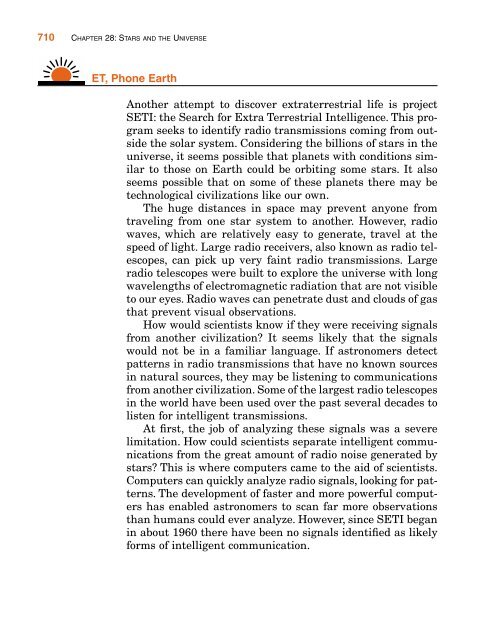Chapter 28 Stars and the Universe
Chapter 28 Stars and the Universe
Chapter 28 Stars and the Universe
You also want an ePaper? Increase the reach of your titles
YUMPU automatically turns print PDFs into web optimized ePapers that Google loves.
710 CHAPTER <strong>28</strong>: STARS AND THE UNIVERSE<br />
ET, Phone Earth<br />
Ano<strong>the</strong>r attempt to discover extraterrestrial life is project<br />
SETI: <strong>the</strong> Search for Extra Terrestrial Intelligence. This program<br />
seeks to identify radio transmissions coming from outside<br />
<strong>the</strong> solar system. Considering <strong>the</strong> billions of stars in <strong>the</strong><br />
universe, it seems possible that planets with conditions similar<br />
to those on Earth could be orbiting some stars. It also<br />
seems possible that on some of <strong>the</strong>se planets <strong>the</strong>re may be<br />
technological civilizations like our own.<br />
The huge distances in space may prevent anyone from<br />
traveling from one star system to ano<strong>the</strong>r. However, radio<br />
waves, which are relatively easy to generate, travel at <strong>the</strong><br />
speed of light. Large radio receivers, also known as radio telescopes,<br />
can pick up very faint radio transmissions. Large<br />
radio telescopes were built to explore <strong>the</strong> universe with long<br />
wavelengths of electromagnetic radiation that are not visible<br />
to our eyes. Radio waves can penetrate dust <strong>and</strong> clouds of gas<br />
that prevent visual observations.<br />
How would scientists know if <strong>the</strong>y were receiving signals<br />
from ano<strong>the</strong>r civilization? It seems likely that <strong>the</strong> signals<br />
would not be in a familiar language. If astronomers detect<br />
patterns in radio transmissions that have no known sources<br />
in natural sources, <strong>the</strong>y may be listening to communications<br />
from ano<strong>the</strong>r civilization. Some of <strong>the</strong> largest radio telescopes<br />
in <strong>the</strong> world have been used over <strong>the</strong> past several decades to<br />
listen for intelligent transmissions.<br />
At first, <strong>the</strong> job of analyzing <strong>the</strong>se signals was a severe<br />
limitation. How could scientists separate intelligent communications<br />
from <strong>the</strong> great amount of radio noise generated by<br />
stars? This is where computers came to <strong>the</strong> aid of scientists.<br />
Computers can quickly analyze radio signals, looking for patterns.<br />
The development of faster <strong>and</strong> more powerful computers<br />
has enabled astronomers to scan far more observations<br />
than humans could ever analyze. However, since SETI began<br />
in about 1960 <strong>the</strong>re have been no signals identified as likely<br />
forms of intelligent communication.

















